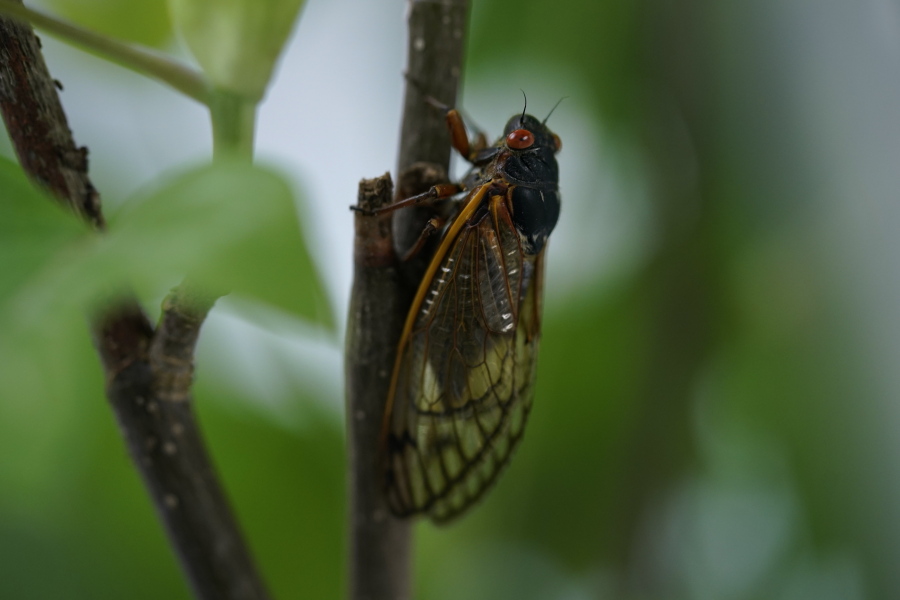In just a short time, an insect infestation of biblical buggy proportions is expected to take place across the eastern United States.
That’s when the hordes of cicadas that are part of Brood X, which appear every 17 years like clockwork, will emerge from underground and start calling — some might say, screaming — for a mate. In some places, there could be more than a million per acre.
For those who need a refresher to better understand the upcoming cicada occurrence — or who weren’t born the last time Brood X made an appearance — here’s an A-to-Z primer on everything you ever wanted to know.
A is for aeration, a natural benefit of all the holes that cicadas dig in the soil.
B is for the billions of bugs that will begin to descend on the eastern United States, most likely this month. It’s possible that the numbers even could get into the trillions.
C is for “Cicada!” the 2018 comedy-horror movie available on Amazon Prime about four friends battling giant, killer cicadas in Los Angeles.
D is for deafening. Cicadas can reach as loud as 90 to 100 decibels, or about the same as a lawnmower.
E is for eating, which is what some people actually do to the bugs. In fact, “The Cicada Cookbook” by Chris Royal offers numerous recipes for readers who want to say, “Bug Appetit!”
F is for flagging, a term used to describe what can happen to tree branches that have been damaged after a female cicada makes a slit in a stem to insert eggs.
G is for Georgia, which is the southernmost state where the cicadas of Brood X are expected to be seen. Their range can extend as far west as the Mississippi River.
H is for the harp, which was paired with the cicada as an emblem of music by the ancient Greeks.
I is for invasion, a word that news outlets have used to describe the coming emergence of the bugs.
J is for late July, when cicada eggs will hatch and nymphs will burrow into the ground.
K is for all the keepsakes this year’s cicada emergence will leave behind, from the creatures’ exoskeletons to the commemorative T-shirts produced by Columbus-based retailer Homage.
L is for locusts, which are totally different from cicadas — and much more destructive — but frequently confused with them.
M is for mate, which is what cicadas are looking for when they start “singing” five days after emerging.
N is for nymphs, the immature form of the insect.
O is for Ohio, where the bugs will be most concentrated in the western part of the state.
P is for periodical cicadas, such as Brood X, which emerge every certain number of years at the same time in massive numbers. There are annual cicadas as well whose appearance is not synchronized.
Q is for the quiet that will be long gone when the cicadas arrive and begin calling for a mate.
R is for the roots of trees and other plants, which nymphs feed off of for 17 years while underground.
S is for safari, something that area residents can enjoy as they help map the emergence of Brood X with the Cicada Safari app. It was developed by Gene Kritsky and the Center for IT Engagement at Mount St. Joseph University in Cincinnati.
T is for temperature, the key determining factor for when cicadas emerge from underground. When ground temperature hits 64 degrees, get ready!
U is for up, which is how you should have your windows if you don’t want cicadas flying into your car. Some caused crashes the last time Brood X appeared in 2004.
V is for villain. In DC Comics, the Cicada is the alias for David Hersch, a cult leader who is an enemy of The Flash.
W is for white, the color that a cicada will appear after molting but before its exoskeleton hardens and it turns black.
X is for the brood that this season’s bugs are part of. Brood X (or 10) emerges every 17 years.
Y is for years. The cicadas of Brood X emerge every 17 years; some other broods appear every 13 years.
Z is for “zombie cicadas.” It’s real — a reference to males who become infected with a fatal, mind-controlling fungus that causes them to imitate the sound of female cicadas and infect other males.



